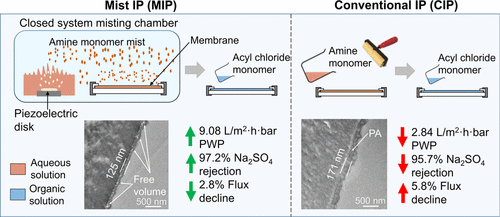当前位置:
X-MOL 学术
›
Ind. Eng. Chem. Res.
›
论文详情
Our official English website, www.x-mol.net, welcomes your
feedback! (Note: you will need to create a separate account there.)
New Concept of Thin-Film Composite Nanofiltration Membrane Fabrication Using a Mist-Based Interfacial Polymerization Technique
Industrial & Engineering Chemistry Research ( IF 3.8 ) Pub Date : 2021-06-16 , DOI: 10.1021/acs.iecr.1c01286 Mei Qun Seah 1 , Ying Siew Khoo 1 , Woei Jye Lau 1 , Pei Sean Goh 1 , Ahmad Fauzi Ismail 1
Industrial & Engineering Chemistry Research ( IF 3.8 ) Pub Date : 2021-06-16 , DOI: 10.1021/acs.iecr.1c01286 Mei Qun Seah 1 , Ying Siew Khoo 1 , Woei Jye Lau 1 , Pei Sean Goh 1 , Ahmad Fauzi Ismail 1
Affiliation

|
The conventional interfacial polymerization (CIP) technique used for preparing thin-film composite (TFC) nanofiltration membranes typically requires a large amount of monomers during polyamide (PA) synthesis where most of the monomers are discarded after cross-linking. Thus, a new fabrication concept is proposed in this work to synthesize a PA layer via a mist-based interfacial polymerization (MIP) technique where only a small amount of aqueous solution is dispersed as mist. This approach also eliminates the rubber-rolling step in CIP. In addition to forming a thinner and looser PA structure, the piperazine solution required in the IP reaction is significantly reduced, that is, 17 times lower than that of CIP. The microdroplet dispersion approach in MIP could form a higher cross-linked PA due to the high polymerization interface besides forming a higher free-volume selective layer due to the disruption in the PA repeat structure. Our findings revealed that the newly developed mist-based TFC membrane could achieve 9.08 L/m2·h·bar pure water permeability and 97.2% Na2SO4 rejection coupled with a complete flux recovery rate. As a comparison, the conventional TFC membrane only attained 2.84 L/m2·h·bar and 95.7%, respectively. The MIP technique could also be potentially considered for developing a nanofiller-incorporated TFC membrane due to the absence of the rubber-rolling step.
中文翻译:

使用雾基界面聚合技术制备薄膜复合纳滤膜的新概念
用于制备薄膜复合 (TFC) 纳滤膜的传统界面聚合 (CIP) 技术通常在聚酰胺 (PA) 合成过程中需要大量单体,其中大部分单体在交联后被丢弃。因此,在这项工作中提出了一种新的制造概念,通过基于雾的界面聚合(MIP)技术合成 PA 层,其中只有少量的水溶液以雾的形式分散。这种方法还消除了 CIP 中的橡胶滚压步骤。除了形成更薄更松散的PA结构外,IP反应所需的哌嗪溶液显着减少,即比CIP低17倍。MIP 中的微滴分散方法可以形成更高交联的 PA,由于高聚合界面,除了由于 PA 重复结构的破坏而形成更高的自由体积选择层。我们的研究结果表明,新开发的雾基 TFC 膜可以达到 9.08 L/m2 ·h·bar 纯水渗透率和 97.2% Na 2 SO 4截留率以及完全的通量回收率。作为比较,传统的TFC 膜仅分别达到2.84 L/m 2 ·h·bar 和95.7%。由于没有橡胶滚压步骤,MIP 技术也可能被考虑用于开发掺入纳米填料的 TFC 膜。
更新日期:2021-06-30
中文翻译:

使用雾基界面聚合技术制备薄膜复合纳滤膜的新概念
用于制备薄膜复合 (TFC) 纳滤膜的传统界面聚合 (CIP) 技术通常在聚酰胺 (PA) 合成过程中需要大量单体,其中大部分单体在交联后被丢弃。因此,在这项工作中提出了一种新的制造概念,通过基于雾的界面聚合(MIP)技术合成 PA 层,其中只有少量的水溶液以雾的形式分散。这种方法还消除了 CIP 中的橡胶滚压步骤。除了形成更薄更松散的PA结构外,IP反应所需的哌嗪溶液显着减少,即比CIP低17倍。MIP 中的微滴分散方法可以形成更高交联的 PA,由于高聚合界面,除了由于 PA 重复结构的破坏而形成更高的自由体积选择层。我们的研究结果表明,新开发的雾基 TFC 膜可以达到 9.08 L/m2 ·h·bar 纯水渗透率和 97.2% Na 2 SO 4截留率以及完全的通量回收率。作为比较,传统的TFC 膜仅分别达到2.84 L/m 2 ·h·bar 和95.7%。由于没有橡胶滚压步骤,MIP 技术也可能被考虑用于开发掺入纳米填料的 TFC 膜。











































 京公网安备 11010802027423号
京公网安备 11010802027423号